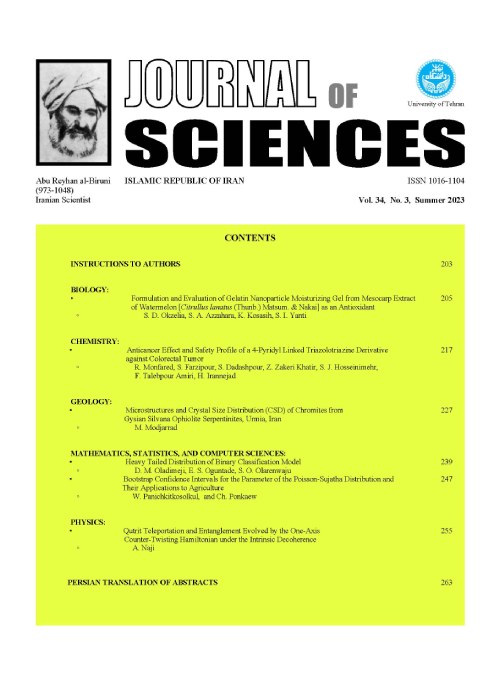Taknar Polymetal (Cu-Zn-Au-Ag-Pb) Deposit: A New Type Magnetite-Rich VMS Deposit, Northeast of Iran
Author(s):
Abstract:
The massive sulfide of Taknar deposits are part of meta volcanic-sedimentary complex (Taknar Formation, Ordovician) and consist of clastic sediments, carbonate, felsic and mafic volcanic and sub-volcanic rocks. The Taknar polymetal deposit shows good layering; therefore it is syngenetic in origin. Taknar zone was affected by low grade metamorphism (Green Schist facies) in the late Paleozoic. As a result, pelitic and subarkosic rocks were changed to sericite or sericite-chlorite schist. Taknar deposit is situated within Taknar zone which is an allochthonous block. This block is situated between two major faults, Drouneh Fault to the south and Rivash (Taknar) Fault to the north. These deposits which are called Tak-I, II, III, and IV, originally were part of one big deposit but due to faulting they are being truncated and moved at least 1 km from each other. Three types of mineralization such as layered, massive and stockwork are present. The layered section is composed of alternating layers of pyrite, chalcopyrite, magnetite, sphalerite, galena and chlorite. The Individual sulphide layers range in thickness from millimeters to 2 cm. Chlorite is the dominate silicate mineral within the layered ore. Massive ore horizons, having >50% magnetite, occur at the stratigraphic top of the mineralized zone. Major minerals are: magnetite + pyrite + chalcopyrite + sphalerite ± galena + chlorite ± quartz ± sericite ± calcite. Pyrite and chalcopyrite content are higher in the lower layers and magnetite, sphalerite and galena are higher within the upper layers. In stockwork mineralization, major minerals are: pyrite + chalcopyrite ± magnetite + quartz + chlorite + sericite ± calcite. Chemical variations of some elements in different deposit are: Tak-I: Cu=0.01-5.86%, Zn=269-15600 (ppm), Pb=27-4400 (ppm), Au=0.86-7 (ppm), Ag=2-95 (ppm), Bi=34-2200 (ppm), and Mo=85-1300 (ppm). Tak-II: Cu=0.33-2.56%, Zn=0.3-7.7%, Pb=93-5000 (ppm), Au=0.33-11 (ppm), Ag=19-105 (ppm), Bi=79-214 (ppm), and Mo=54-116 (ppm). Tak-III: Cu=0.05-5.54%, Zn=62-179 (ppm), Pb=17-47 (ppm), Au=0.06-0.33 (ppm), Ag=2-40 (ppm), and Bi=11-250 (ppm). Based on paragenesis, alteration, style of mineralization, petrography, geochemistry, and structure, Taknar is a new type of magnetite rich polymetal volcanic massive sulfide deposit. Lack of pyrrhotite and high magnetite associated with sulfide minerals make this deposit very different from other VMS deposit. Based on the mineral paragenesis the estimated physiochemical conditions of formation are: Tak-I: T °C ≥ 250, Log f O2=(-29) to (-30), pH=5-7. Tak-II: T °C ≤ 250, Log f S2=(-11) to (-12), Log f O2=(-36) to (-39), 59. Tak-III: T °C ≥ 270, Log f O2=(-28) to (-29), pH>5.
Language:
English
Published:
Journal of Sciences, Islamic Republic of Iran, Volume:16 Issue: 3, Summer 2005
Page:
239
magiran.com/p638541
دانلود و مطالعه متن این مقاله با یکی از روشهای زیر امکان پذیر است:
اشتراک شخصی
با عضویت و پرداخت آنلاین حق اشتراک یکساله به مبلغ 1,390,000ريال میتوانید 70 عنوان مطلب دانلود کنید!
اشتراک سازمانی
به کتابخانه دانشگاه یا محل کار خود پیشنهاد کنید تا اشتراک سازمانی این پایگاه را برای دسترسی نامحدود همه کاربران به متن مطالب تهیه نمایند!
توجه!
- حق عضویت دریافتی صرف حمایت از نشریات عضو و نگهداری، تکمیل و توسعه مگیران میشود.
- پرداخت حق اشتراک و دانلود مقالات اجازه بازنشر آن در سایر رسانههای چاپی و دیجیتال را به کاربر نمیدهد.
دسترسی سراسری کاربران دانشگاه پیام نور!
اعضای هیئت علمی و دانشجویان دانشگاه پیام نور در سراسر کشور، در صورت ثبت نام با ایمیل دانشگاهی، تا پایان فروردین ماه 1403 به مقالات سایت دسترسی خواهند داشت!
In order to view content subscription is required
Personal subscription
Subscribe magiran.com for 70 € euros via PayPal and download 70 articles during a year.
Organization subscription
Please contact us to subscribe your university or library for unlimited access!


